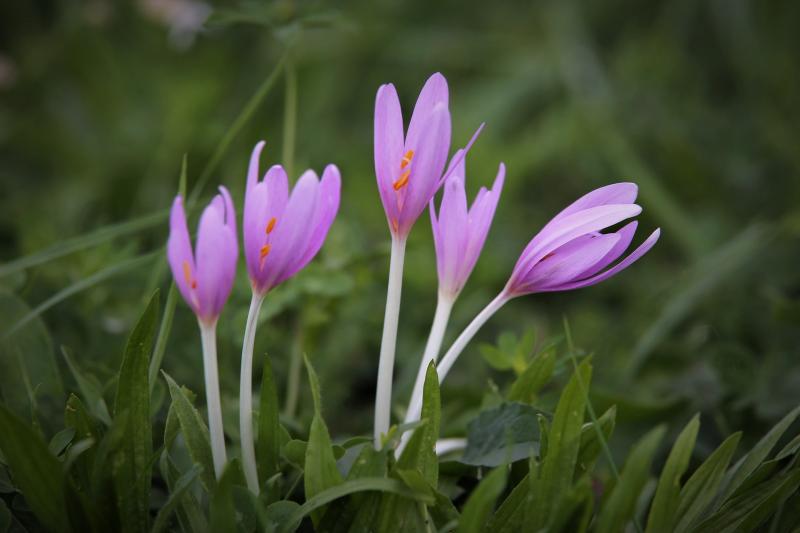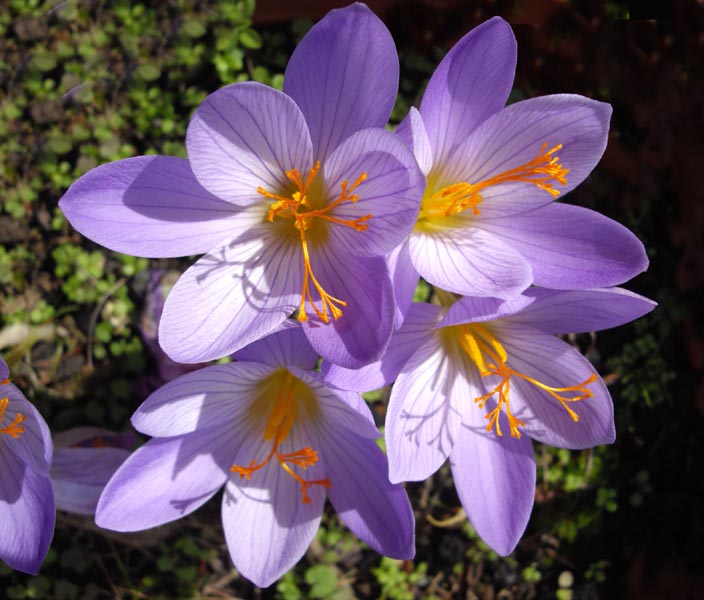
While most gardeners are familiar with spring-flowering bulbs, such as tulips and daffodils, many don't realize that some bulbs actually bloom in the fall. These fall-blooming bulbs make unexpected, colorful additions to the fall garden.
Autumn Crocus
Despite it's common name, Colchicum autumnale is not a true crocus. In fact, Colchicum and Crocus are not even in the same family.
It's also sometimes called meadow saffron, although it's not the source of culinary saffron. (Oh, the confusion caused by common names!) And beware - although beautiful, autumn crocus is a toxic plant so you won't want to eat any part of it.
Here's another falsity - Colchium grows from corms, not bulbs - sorry to be misleading! One final shocking fact, plants are also sometimes called "naked ladies" because the 2-3" wide crocus-like flowers - in white, pink or lavender - appear without foliage in the fall. Leaves, somewhat like tulip or hosta foliage, are produced in spring, but die back and go dormant as summer heat increases. The leaves may be up to 10 to 15 inches long and 3 to 4 inches wide. In fall, the flowers spring from bare ground "naked" of foliage.
A risque little plant, but a fun addition for fall garden color. Just make sure you don't have any pets (or kids) prone to eating plant foliage or bulbs.
Attractive varieties include the following.
- Colchicum autumnale 'Album' which produces white flowers and 'Alboplenum' which is a double, white-flowering form.
- 'The Giant' produces large, violet flowers with white throats.
- The flowers of 'Waterlily' resemble waterlily blossoms. The large, double, purplish-pink flowers contain up to 20 petals.
Planting Autumn Crocus
Colchicums should be planted immediately after arrival or purchase in the fall - they often bloom in storage if not planted immediately.
Select a location with full sun to partial shade. Colchicums require well-drained soils. Since the dying foliage of colchicums is unattractive, gardeners should carefully select their planting sites, so the foliage is hidden by other plants. Good locations would be the front of a shrub border or under the filtered shade of large trees or shrubs. Plant the bulbs in masses 3 inches deep and 6 inches apart.
Colchicums are hardy to USDA Hardiness Zone 5.
 Showy Crocus
Showy Crocus
This fall bloomer is a true crocus, but not a true bulb. It actually grows from a corm, just like the Colchicums. (Drat, is there no truth to be had?) To muddy the water a little more, it's also sometimes called autumn crocus, just like Colchicum autumnale. (Enough with the confusion already, right?) Just make sure you double check the catalog or plant tag so you know what you're buying.
Actually, there are several species of crocus that bloom in the fall and winter, but plant breeders have focused more on developing spring-blooming species. This leaves the fall-bloomers under the gardening public's radar.
Showy crocus, Crocus speciosus, is the most commonly grown of the fall-blooming crocus. It has violet blue flowers with yellow anthers and deep orange stigmas. Plant height is approximately 5 to 6 inches.
Excellent varieties include 'Cassiope' which produces aster blue flowers with yellow bases and 'Conqueror' with clear, deep blue flowers.
Showy crocus is easy to grow. Choose a well-drained site in partial shade to full sun. Plant the corms during their July and August dormant period. Since the flowers are small, place the corms in masses to achieve the best visual impact. The corms should be planted 3 to 4 inches deep and 4 to 6 inches apart, with the flattest side down. Most fall-blooming crocus are hardy to Zone 3, except saffron crocus which is hardy to Zone 6.
So, when browsing through bulb catalogs and garden centers this fall, consider some fall blooming bulbs - er, sorry "corms". They make pretty additions to the fall landscape. Just keep in mind, depending on the vigor of the corms you purchased and when you got them planted, they may not bloom for you until next fall.
Will the deception never end?
Images
- Feature image - Colchicum autumnale from Pixabay.com
- Lower right - 'Conqueror' Crocus speciosus. Ghislain 118, CC BY-SA 3.0.